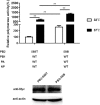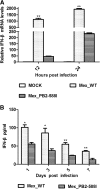PB2-588I enhances 2009 H1N1 pandemic influenza virus virulence by increasing viral replication and exacerbating PB2 inhibition of beta interferon expression
- PMID: 24335306
- PMCID: PMC3911566
- DOI: 10.1128/JVI.03024-13
PB2-588I enhances 2009 H1N1 pandemic influenza virus virulence by increasing viral replication and exacerbating PB2 inhibition of beta interferon expression
Abstract
The 2009 pandemic H1N1 influenza virus (pdm/09) is typically mildly virulent in mice. In a previous study, we identified four novel swine isolates of pdm/09 viruses that exhibited high lethality in mice. Comparing the consensus sequences of the PB2 subunit of human isolates of pdm/09 viruses with those of the four swine isolate viruses revealed one consensus mutation: T588I. In this study, we determined that 588T is an amino acid mutation conserved in pdm/09 viruses that was exceedingly rare in previous human influenza isolates. To investigate whether the PB2 with the T5581 mutation (PB2-T558I) has an effect on the increased pathogenicity, we rescued a variant containing PB2-588I (Mex_PB2-588I) in the pdm/09 virus, A/Mexico/4486/2009(H1N1), referred to as Mex_WT (where WT is wild type), and characterized the variant in vitro and in vivo. The results indicated that the mutation significantly enhanced polymerase activity in mammalian cells, and the variant exhibited increased growth properties and induced significant weight loss in a mouse model compared to the wild type. We determined that the mutation exacerbated PB2 inhibition of mitochondrial antiviral signaling protein (MAVS)-mediated beta interferon (IFN-β) expression, and PB2-588I was observed to bind to MAVS more efficiently than PB2-588T. The variant induced lower levels of host IFN-β expression than the WT strain during infection. These findings indicate that the pdm/09 influenza virus has increased pathogenicity upon the acquisition of the PB2-T588I mutation and highlight the need for the continued surveillance of the genetic variation of molecular markers in influenza viruses because of their potential effects on pathogenicity and threats to human health.
Figures






Similar articles
-
The PB2 subunit of the influenza virus RNA polymerase affects virulence by interacting with the mitochondrial antiviral signaling protein and inhibiting expression of beta interferon.J Virol. 2010 Sep;84(17):8433-45. doi: 10.1128/JVI.00879-10. Epub 2010 Jun 10. J Virol. 2010. PMID: 20538852 Free PMC article.
-
The R251K Substitution in Viral Protein PB2 Increases Viral Replication and Pathogenicity of Eurasian Avian-like H1N1 Swine Influenza Viruses.Viruses. 2020 Jan 2;12(1):52. doi: 10.3390/v12010052. Viruses. 2020. PMID: 31906472 Free PMC article.
-
Mutations in polymerase genes enhanced the virulence of 2009 pandemic H1N1 influenza virus in mice.PLoS One. 2012;7(3):e33383. doi: 10.1371/journal.pone.0033383. Epub 2012 Mar 15. PLoS One. 2012. PMID: 22438920 Free PMC article.
-
Virulence of pandemic (H1N1) 2009 influenza A polymerase reassortant viruses.Virulence. 2011 Sep-Oct;2(5):422-6. doi: 10.4161/viru.2.5.17267. Epub 2011 Sep 1. Virulence. 2011. PMID: 21921678 Review.
-
PA and PA-X: two key proteins from segment 3 of the influenza viruses.Front Cell Infect Microbiol. 2025 Mar 14;15:1560250. doi: 10.3389/fcimb.2025.1560250. eCollection 2025. Front Cell Infect Microbiol. 2025. PMID: 40160474 Free PMC article. Review.
Cited by
-
The Nucleoprotein of H7N9 Influenza Virus Positively Regulates TRAF3-Mediated Innate Signaling and Attenuates Viral Virulence in Mice.J Virol. 2020 Nov 23;94(24):e01640-20. doi: 10.1128/JVI.01640-20. Print 2020 Nov 23. J Virol. 2020. PMID: 33028715 Free PMC article.
-
Prevalence, Genetics and Evolutionary Properties of Eurasian Avian-like H1N1 Swine Influenza Viruses in Liaoning.Viruses. 2022 Mar 20;14(3):643. doi: 10.3390/v14030643. Viruses. 2022. PMID: 35337050 Free PMC article.
-
Fitness Determinants of Influenza A Viruses.Viruses. 2023 Sep 20;15(9):1959. doi: 10.3390/v15091959. Viruses. 2023. PMID: 37766365 Free PMC article. Review.
-
A novel pro-inflammatory protein of Streptococcus suis 2 induces the Toll-like receptor 2-dependent expression of pro-inflammatory cytokines in RAW 264.7 macrophages via activation of ERK1/2 pathway.Front Microbiol. 2015 Mar 9;6:178. doi: 10.3389/fmicb.2015.00178. eCollection 2015. Front Microbiol. 2015. PMID: 25806027 Free PMC article.
-
Amino acid substitutions in low pathogenic avian influenza virus strains isolated from wild birds in Korea.Virus Genes. 2018 Jun;54(3):397-405. doi: 10.1007/s11262-018-1550-7. Epub 2018 Mar 26. Virus Genes. 2018. PMID: 29582231
References
-
- Berhane Y, Ojkic D, Neufeld J, Leith M, Hisanaga T, Kehler H, Ferencz A, Wojcinski H, Cottam-Birt C, Suderman M, Handel K, Alexandersen S, Pasick J. 2010. Molecular characterization of pandemic H1N1 influenza viruses isolated from turkeys and pathogenicity of a human pH1N1 isolate in turkeys. Avian Dis. 54:1275–1285. 10.1637/9422-061410-Reg.1 - DOI - PubMed
-
- Sponseller BA, Strait E, Jergens A, Trujillo J, Harmon K, Koster L, Jenkins-Moore M, Killian M, Swenson S, Bender H, Waller K, Miles K, Pearce T, Yoon KJ, Nara P. 2010. Influenza A pandemic (H1N1) 2009 virus infection in domestic cat. Emerg. Infect. Dis. 16:534–537. 10.3201/eid1603.091737 - DOI - PMC - PubMed
Publication types
MeSH terms
Substances
LinkOut - more resources
Full Text Sources
Other Literature Sources
Miscellaneous

